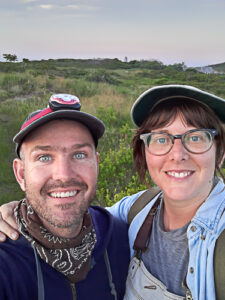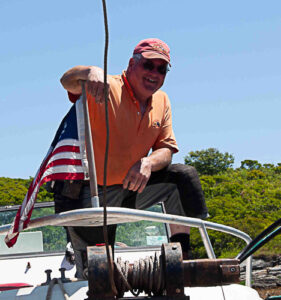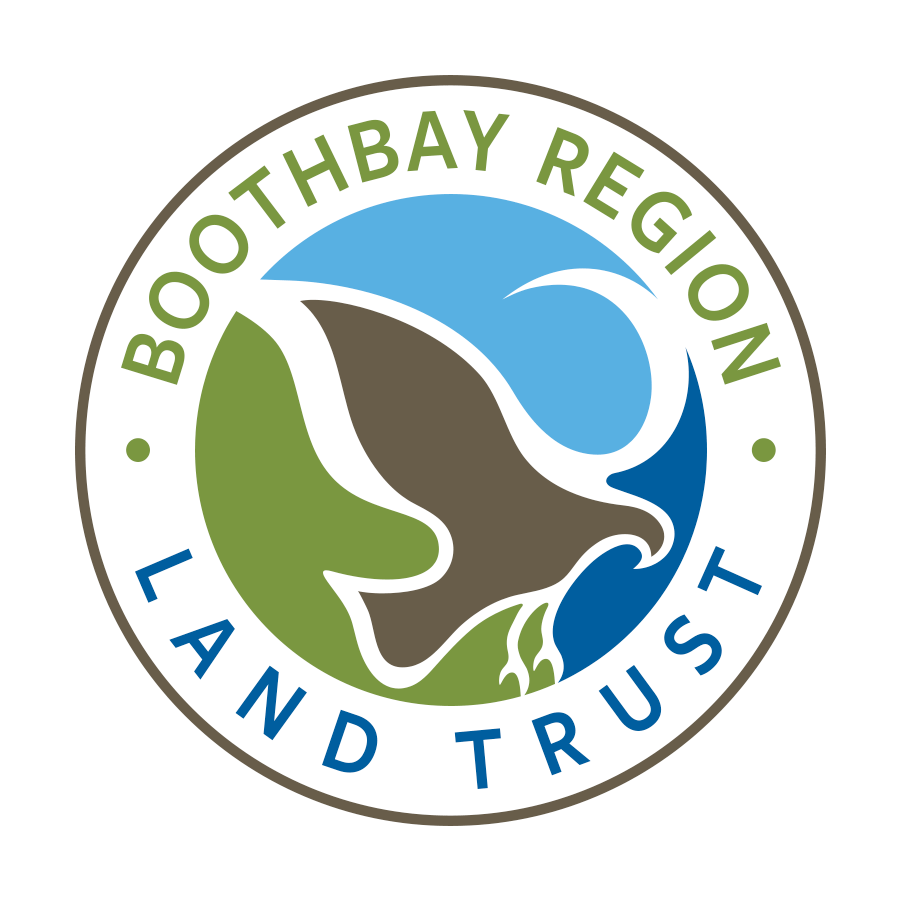In recognition of Boothbay Region Land Trust’s 40th anniversary, we will be releasing a series of four short films with companion articles highlighting some of our most iconic nature preserves. The series will touch upon the histories, features, uses and environmental significance of each featured property. The third in this series recognizes Damariscove Island.
Finding Connections on Damariscove Island
 In June of 2019, when Bailey Romaine and Ed Vlcek first arrived as seasonal caretakers on Boothbay Region Land Trust’s Damariscove Island, they were immediately struck by the stark contrast between the island and the home they had left behind in Chicago. “Everything out here [on Damariscove] is kind of in high definition,” Bailey explains. “The light for one, but also how aware you are of what the birds are doing, what the tides are doing, the smells, the sounds. When the wind shifts, suddenly you hear the warning bell at The Motions [a series of rock ledges on the island’s south end]. All of these things make living on the island a full sensory experience,” she notes. Coming from a bustling metropolis to an uninhabited island may seem like a move away from sensory stimulation, but in many ways, Ed and Bailey have found the opposite to be true.
In June of 2019, when Bailey Romaine and Ed Vlcek first arrived as seasonal caretakers on Boothbay Region Land Trust’s Damariscove Island, they were immediately struck by the stark contrast between the island and the home they had left behind in Chicago. “Everything out here [on Damariscove] is kind of in high definition,” Bailey explains. “The light for one, but also how aware you are of what the birds are doing, what the tides are doing, the smells, the sounds. When the wind shifts, suddenly you hear the warning bell at The Motions [a series of rock ledges on the island’s south end]. All of these things make living on the island a full sensory experience,” she notes. Coming from a bustling metropolis to an uninhabited island may seem like a move away from sensory stimulation, but in many ways, Ed and Bailey have found the opposite to be true.
 “In Chicago and really anywhere within our modern world, we are always moving around,” Ed explains. “It usually feel like the world is stationary, and we are moving through it. But on Damariscove, it really feels like we’re here.” BRLT’s seasonal caretakers spend ten weeks on the 210 acres island six miles off the coast of Maine, from early June through Labor Day weekend. On any given day, Ed and Bailey’s work only ever brings them within a short walk of the caretakers’ cabin where they live throughout the summer. Living and working on a small island day in and day out has allowed Bailey and Ed to appreciate the patterns of life that are so often missed in the busy hustle of the outside world. They note feeling connected to the succession of plants throughout the season, from the rose buds of early summer to the goldenrod of late summer, and seeing how different species come and go in cyclical patterns, including birds, dragonflies and monarchs. “Because we’re here constantly, we’re tuned into everything around us,” Bailey explains. So while some think of the island as disconnected from the world, Ed and Bailey describe a unique connection to their surroundings in which the sounds and sights all have meaning and they are far more aware of what is happening around them than they could ever feel in urban Chicago or any other place that they have lived.
“In Chicago and really anywhere within our modern world, we are always moving around,” Ed explains. “It usually feel like the world is stationary, and we are moving through it. But on Damariscove, it really feels like we’re here.” BRLT’s seasonal caretakers spend ten weeks on the 210 acres island six miles off the coast of Maine, from early June through Labor Day weekend. On any given day, Ed and Bailey’s work only ever brings them within a short walk of the caretakers’ cabin where they live throughout the summer. Living and working on a small island day in and day out has allowed Bailey and Ed to appreciate the patterns of life that are so often missed in the busy hustle of the outside world. They note feeling connected to the succession of plants throughout the season, from the rose buds of early summer to the goldenrod of late summer, and seeing how different species come and go in cyclical patterns, including birds, dragonflies and monarchs. “Because we’re here constantly, we’re tuned into everything around us,” Bailey explains. So while some think of the island as disconnected from the world, Ed and Bailey describe a unique connection to their surroundings in which the sounds and sights all have meaning and they are far more aware of what is happening around them than they could ever feel in urban Chicago or any other place that they have lived.
This is not the only way in which Ed and Bailey’s sense of connectivity has been enhanced during their time on Damariscove. Over the past two summers as island caretakers, the couple has developed an appreciation for the unique ways in which Damariscove Island is a hub of community, often bringing people together. On an island where people come to work, to reminisce, to stopover, or to get away, Ed and Bailey found most days to be anything but isolating. Throughout much of the summer there is a vibrant community based out on Damariscove, from lobstermen who work off of the stone pier or nearby floats, to the neighbors at the former lifesaving station, the island’s only other summer residents. Ed and Bailey recall being struck by the kindness of this local community. “The way in which we were welcomed and seamlessly accepted as part of this collective when we were basically strangers from a far away place was amazing,” Ed recalls.
 As a BRLT volunteer, Gerry Gamage, whose grandfather once had charge of the old lifesaving station on Damariscove, brings Ed and Bailey on and off the island every ten days, allowing them a few days off and an opportunity to restock their supplies. Ed and Bailey recall on one recent occasion returning late to catch a ride with Gerry back to the island after getting a flat tire. They anticipated needing to fix the tire on their next day off, but when they returned to their car, the tire had been fixed. “Gerry fixed it for us,” Ed explains. “He didn’t even mention it. It’s that kind of kindness that we’ve found out here.”
As a BRLT volunteer, Gerry Gamage, whose grandfather once had charge of the old lifesaving station on Damariscove, brings Ed and Bailey on and off the island every ten days, allowing them a few days off and an opportunity to restock their supplies. Ed and Bailey recall on one recent occasion returning late to catch a ride with Gerry back to the island after getting a flat tire. They anticipated needing to fix the tire on their next day off, but when they returned to their car, the tire had been fixed. “Gerry fixed it for us,” Ed explains. “He didn’t even mention it. It’s that kind of kindness that we’ve found out here.”
Ed and Bailey also noticed a community that extends far beyond the immediate regulars who frequent the island for work or livelihood. Many of the visitors who come back to Damariscove year after year maintain a deep connection to the place. “We talk to so many people and hear so many stories of people who have been coming out for years and sharing their memories of the island,” Bailey explains. “It was surprising for us to recognize the cultural significance the island holds for people.” Bailey and Ed describe how much of their days are spent talking to people, who often seek them out upon arriving to shore. The pair note that they have interacted more with people as caretakers on a given day of the summer than they do during the off-season living in South Bristol. “People come out here and they really want to talk,” Bailey explains. “They want to meet  the caretakers and connect with us and hear what is happening, but also share their memories and experiences on Damariscove.” Bailey and Ed have observed countless visitors coming to share the island with children or grandchildren, telling stories of their own childhood visits to the island, and connecting the next generation to the island and its history. Bailey sums it up: “Damariscove is a special part of so many people’s lives.”
the caretakers and connect with us and hear what is happening, but also share their memories and experiences on Damariscove.” Bailey and Ed have observed countless visitors coming to share the island with children or grandchildren, telling stories of their own childhood visits to the island, and connecting the next generation to the island and its history. Bailey sums it up: “Damariscove is a special part of so many people’s lives.”
It may seem odd or unexpected that a remote, uninhabitated island off the coast of Maine offers such meaningful and diverse connections for so many. Yet perhaps it should not surprise us at all. The island was the first permanent European settlement in Maine. It has a continuous fishing history that dates back long before Europeans had arrived, when Abanaki visited Damariscove, which they called Aquahega or “place of landing.” As far back as history has been kept, Damariscove has been a place where community gathered, to fish, to stopover, or to appreciate nature. Today these continue to be the activities that bring communities together on a rugged piece of land six miles out to sea.





